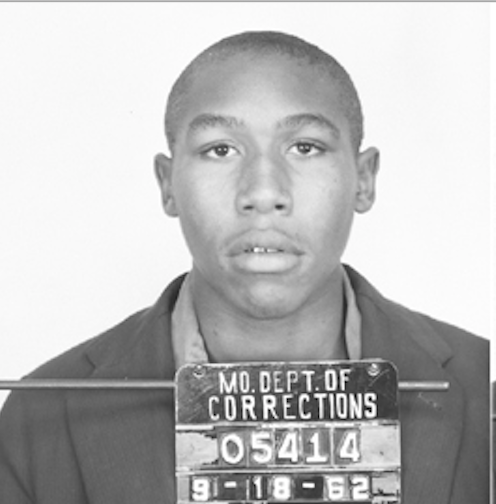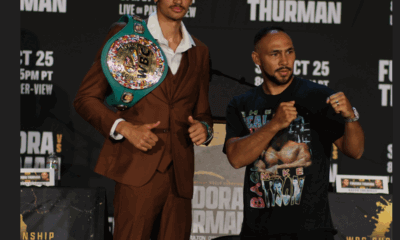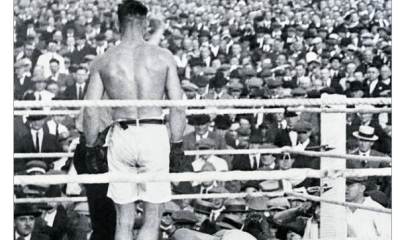Featured Articles
Jeff “Candy Slim” Merritt: A Fighter’s Life

They were sad eyes, those eyes of his. Despite his six feet and five inches in height they always seemed to be staring up at you, like a child looking up at a disappointed father. Maybe it was that he felt more comfortable with his picture being taken if it was for a mug shot than a publicity photo. They belied the man’s insecurity that was hidden so well behind a monstrous left hook. As one of his former trainers, Angelo Dundee, once said, “He was an awful mixed up kid, he always was.” Those eyes never gave any indication of the man’s profession. He was a fighter. Indeed, Jeff Merritt had been a fighter most of his life.
By his own admission, Merritt had been a shy, self conscious child. He walked in fear of the neighborhood bullies and street toughs. So, when confronted on the streets of his native Kansas City, he would often lash out first and viciously. At 15, he stood six foot one and a half inches and weighed 177 pounds. Although, Merritt channeled this rage in the boxing ring, his burgeoning amateur career was cut short when he was sent to the Booneville Reformatory for Juvenile Criminal Delinquency in May of 1962 as a result of his street fights.
Boonville was an infamous facility that was converted to a men’s prison in 1983 after years of notoriously brutal treatment of the youths housed there. Boonville was overcrowded and extremely violent. Little care was given to rehabilitation and as a result recidivism was high. Children as young as eight found themselves incarcerated with youths as old as 21. Boys incarcerated for the relatively minor offense of truancy found themselves bunking with murderers. Rapes were common and fights were a way of life. Many of the boys who found themselves behind the walls of Boonville left forever changed, damaged and without the skills to build a life for themselves.
Jeff Merritt walked into this hellish nightmare and, as large as most full grown men, continued his policy of hitting first and hitting hard. As a result of this behavior, Merritt was transferred to the Missouri State Penitentiary at Jefferson City less than four months after being admitted to Boonville. The Missouri State Penitentiary was the oldest prison west of the Mississippi and nicknamed the “bloodiest 47 acres in America.” It seemed Merritt, at the age of 15, had jumped from the frying pan into the fire.
One week to the day after arriving at the Penitentiary, an event happened that may have had some impact on the direction Merritt’s life would take in the coming years. On September 25, 1962, Sonny Liston, one of the most famous inmates to ever come out of the MSP, won the most coveted prize in sports, the heavyweight championship of the world. For a kid sitting behind those melancholy walls, Liston’s victory must have served as a shining beacon of hope. Yet it would be several years before Merritt would re-enter the world of boxing.
Jeff was paroled from the MSP on July 24, 1963 and returned to Kansas City. For the next year and a half Merritt worked odd jobs but, with a 9th grade education, his options were limited and at the start of 1965 he reverted to a life of crime. Over a period of ten months Merritt was arrested no less than seven times for offenses ranging from carrying a concealed weapon to armed robbery and from aggravated assault to rape. On November 2, 1965 he was convicted of 1st degree robbery and sent back to the MSP for a seven year stretch. Walking into the MSP for the second time, Merritt was now a solid six foot two and a half inches tall and one hundred ninety-one pounds and still growing. Very quickly, Merritt was training in the prison gymnasium and even found himself working a heavy bag that had once belonged to Sonny Liston and still had his name written on it.
Merritt showed so much promise that two months after finding himself behind prison bars he was on the team representing the prison in a tournament being hosted there. Merritt was one of only two boxers on the team to win their bouts, defeating Roy Rodriguez via decision after three rounds. The following year, Merritt won the Missouri Valley AAU boxing championship which the MSP hosted. Under any other circumstances, the victory would have awarded him the opportunity to compete in the National AAU tournament held in San Diego that April but Merritt’s status as an incarcerated felon prevented such a trip.
Merritt continued to train and participate in whatever bouts he could get behind prison walls and, at some point, he had occasion to enter the ring against first round NFL draft pick Francis Peay who had played offensive tackle at the nearby University of Missouri. It took only one round with the lanky 20 year old for the six foot four inch two hundred and forty six pound Peay to give up any hope of a boxing career. Thoroughly impressed, Peay returned to New York where he played for the Giants.
In the off season Peay kept in shape by boxing at the state-of-the-art gymnasium in the National Maritime Union’s recently built eleven million dollar annex on 9th Avenue. Former heavyweight champion Joe Louis and former featherweight champion Sandy Saddler had been hired by the Union as physical instructors for its members and the vocational school they had recently opened. The Union was putting together a team of professional boxers with George Albert and Chris Jacman promoting their fights out of the Union Hall on 7th Avenue. One day Peay ran into the two ex champions and gushed over the lanky power-punching fighter incarcerated in Missouri. Their interest peaked; Louis, Saddler, and a handful of officials from the Union made the trek to Jefferson City to see the young phenom for themselves.
The prison agreed to accommodate what took on the appearance of a tryout. A ring was set up on the prison baseball field. With the Union contingent and one thousand inmates looking on, Merritt would face three other prison boxers, one at a time, disposing of each in a round apiece. Louis and Saddler were impressed. They made it clear that the Union wanted to be in the Jeff Merritt business.
Two months after the exhibition, Joe Louis appeared on Merritt’s behalf before the parole board. Louis stated that if the board would grant Merritt’s parole, the National Maritime Union was prepared to offer Merritt a job, training, financial support, housing, and management. The parole board was amenable on condition that the New York parole board agreed to take over his case. When these conditions were met the following month, Merritt was granted parole. On January 18, 1968, Jeff Merritt left Missouri State Penitentiary a free man. As the legendary blues singer Leadbelly had once sang his way out of prison, Merritt had now fought his way out of prison and seemed destined for stardom.
Merritt moved to New York and, one month after being released, turned professional with a first-round knockout of Ronnie Williams at the National Maritime Union Hall. The next month, he climbed off the canvas to win a four-round decision over Joe Belton. Followed by another first round knockout a month later against similarly non-descript competition. The opponents may not have been threatening, but Jeff was building his confidence, establishing himself, and most importantly he was learning.
Every developing fighter dreams of fighting in Madison Square Garden, hence it was known affectionately as “the Mecca of Boxing.” When a fighter fought in the Garden he knew he was on his way. Merritt not only made it to the Garden in his fourth professional fight but he had the honor of appearing on the undercard of the heavyweight championship fight between Joe Frazier and Manuel Ramos. In an excellent showcase for the young fighter, before a crowd of nearly 11,000, Merritt stopped Milton Torres in the first round.
Three months later, Merritt would return to the Garden and suffer his first defeat. Fighting on the undercard of a heavyweight extravaganza that saw Buster Mathis stop James J. Woody and George Chuvalo stop Manuel Ramos, Jeff was stopped in the third round by a sparring partner of Joe Frazier named Johnny Gause. The fight was action packed, with Gause hitting the deck twice in the first round only to climb off the canvas to stop Merritt. Luckily for Merritt, the fight got very little press coverage and was nothing more than a speed bump for his career.
Merritt returned to the comfortable confines of the Union Hall for a confidence building win over Jimmy Patterson two months later, but his days with the Union were rapidly coming to a close. Early in 1969, a disgruntled union member filed a lawsuit in federal court against the union leadership, charging misuse of union funds in the support of boxers. From that point on, the Union’s association with boxers was officially reserved to sponsoring amateur fighters. However, William Perry, assistant to Union President Joseph Curran, maintained Jeff’s contract and continued to get him fights on the east coast.
As the Union fought dissent within its ranks, Merritt’s career continued to progress, and the decision was made to increase his level of competition. He was first matched in Philadelphia with local undefeated heavyweight prospect Roy Williams. Williams, like Merritt, was a talented and dangerous prospect. At six feet five inches, Williams could match Merritt’s height; and like Merritt, he was a regional AAU and Golden Gloves champion. Unlike Merritt, Williams was undefeated and had faced significantly better opposition as both an amateur and a professional. Also, like Merritt, Williams would become one of boxing’s great “what-if” stories. He was a man that seemed to have it all, but bad luck and his own complacency in the ring prevented him from ever getting the big money fights. Complacency seemed to be Williams’ greatest weakness. He would often start slowly and most of his losses were due largely to his inability or unwillingness to let his hands go.
Williams’ first loss to Merritt set the pattern for his future defeats. Williams, when faced with a man as big, strong, and hard hitting as himself, simply could not get untracked. He quickly fell behind on points as Merritt chased and punched him with little reply. In the fifth, Williams landed one of his infrequent combinations and dropped Merritt for a mandatory 8 count. When the referee waved the fighters together, Williams inexplicably returned to retreating and allowed Merritt to clear his head. Jeff went back to outpointing Williams to win a clear eight round decision. It had been Jeff’s longest fight and most dangerous opponent to date, yet he passed the test with flying colors.
Two more quick stoppages followed over the next two months before Merritt was matched with another more experienced Philadelphian. Roger Russell had been a national AAU light heavyweight champion before turning pro and had recently moved into the heavyweight ranks with an upset win over contender Leotis Martin. After the Martin fight, Russell had managed a draw with former title challenger Zora Folley in a tedious contest, but had slipped with three straight losses and hoped to get back into the win column with a victory over Merritt in a showcase fight on the undercard of Joe Frazier’s title defense against Jerry Quarry. However, Merritt proved too big and too strong for Russell and won the unanimous decision.
Two months later, Merritt was scheduled to appear on the undercard of another event featuring young heavyweight prospects at Madison Square Garden, to be headlined by Olympic champion George Foreman’s bout with Chuck Wepner. A week before the bout, Pires pulled out and California’s Henry Clark was substituted. Clark, a big athletic heavyweight with solid skills and experience, patterned himself after Muhammad Ali. Having been in the ring with Sonny Liston, Zora Folley, Eddie Machen, Leotis Martin, and Florida’s Al Jones, Clark was easily Merritt’s most seasoned opponent. Jeff got off to an early lead before the two fighters closed out the fight with a final round replete with action that brought the crowd to their feet. Once again, Merritt was proclaimed the winner and once again Garden matchmaker Teddy Brenner invited him back to the Mecca of boxing.

*Part I of a III part series
Check out more boxing news on video at The Boxing Channel
-

 Book Review4 weeks ago
Book Review4 weeks agoMark Kriegel’s New Book About Mike Tyson is a Must-Read
-

 Featured Articles3 weeks ago
Featured Articles3 weeks agoThe Hauser Report: Debunking Two Myths and Other Notes
-

 Featured Articles3 weeks ago
Featured Articles3 weeks agoMoses Itauma Continues his Rapid Rise; Steamrolls Dillian Whyte in Riyadh
-

 Featured Articles3 weeks ago
Featured Articles3 weeks agoNikita Tszyu and Australia’s Short-Lived Boxing Renaissance
-

 Featured Articles4 weeks ago
Featured Articles4 weeks agoKotari and Urakawa – Two Fatalities on the Same Card in Japan: Boxing’s Darkest Day
-

 Featured Articles3 weeks ago
Featured Articles3 weeks agoIs Moses Itauma the Next Mike Tyson?
-

 Featured Articles2 weeks ago
Featured Articles2 weeks agoBoxing Odds and Ends: Paul vs ‘Tank,’ Big Trouble for Marselles Brown and More
-

 Featured Articles3 weeks ago
Featured Articles3 weeks agoAvila Perspective, Chap. 340: MVP in Orlando This Weekend




















